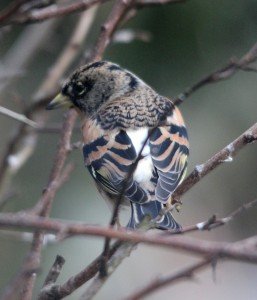 At the end of each winter, roughly in the second half of March, depending on the weather, I choose, from the garden birds, my “Bird of the Winter”. This year is different as it is obvious already that the end result will be one of two different birds unless, of course, anything unexpected happens. One of the two contenders is the brambling, a bird that is often overlooked, as it often blends in with the chaffinches. The problem is that there are so many chaffinches, especially if there is mixed grain on offer, and so few bramblings in comparison. Normally there are around fifty or even more chaffinches to every brambling so it means you have to look very closely to see the difference.
At the end of each winter, roughly in the second half of March, depending on the weather, I choose, from the garden birds, my “Bird of the Winter”. This year is different as it is obvious already that the end result will be one of two different birds unless, of course, anything unexpected happens. One of the two contenders is the brambling, a bird that is often overlooked, as it often blends in with the chaffinches. The problem is that there are so many chaffinches, especially if there is mixed grain on offer, and so few bramblings in comparison. Normally there are around fifty or even more chaffinches to every brambling so it means you have to look very closely to see the difference.
It is all very well the books pointing out the diagnostic features such as the orange brown of the bramblings with the males having a blackish head. In fact, in winter neither of these colour variations and differences are that obvious. One feature that does stand out is the white rump of the brambling but, of course, this is mainly diagnostic when the bird is in flight. However, when it is flitting around on the ground or in branches it often shows part of its white rump feathers. The photograph of the male brambling I took in the garden last week illustrates the point. The bird was flitting around on twigs and then darting to a nearby feeder filled with sunflower hearts. You can just see part of the white rump feathers but enough to identify the bird. Just to confuse matters, the female bramblings are much duller than the males with no blackish head feather’s so they are even more like chaffinches. At the moment there area around a hundred chaffinches in the garden feeding on mixed grain. What will make the bramblings the winter contender is that there are no less than five male bramblings and two female bramblings.
The other contender for the “Bird of the Winter” is the greenfinch and, unlike the bramblings, they are not likely to be confused with any other birds in the garden. It is a very large and somewhat rotund finch and is virtually a greenish yellow colour all over. They are similar in size to house sparrows and chunky looking with a forked tail and large head with a heavy looking conical beak. In the last two years the greenfinch has undergone quite drastic changes in its numbers, including the numbers that visit gardens. A disease, called Trichomonosis, decimated their numbers and in many gardens this was obvious. Last year, for example, in our garden in Strathnairn you had to look hard to see any greenfinches. Their “wheezing” call notes were notable by their absence. They did not come in to many gardens and in our garden sometimes there were two at the most. This winter has been completely different, as two weeks ago I counted no less than forty greenfinches at the feeders at the same time. This week it has gone down to just over thirty but still exceptional for the numbers in recent years. Nobody seems to know why this change in good fortune although the reference books indicate that in some years, although our breeding birds are resident, we get invaded by greenfinches from Scandinavia and even Russia.
